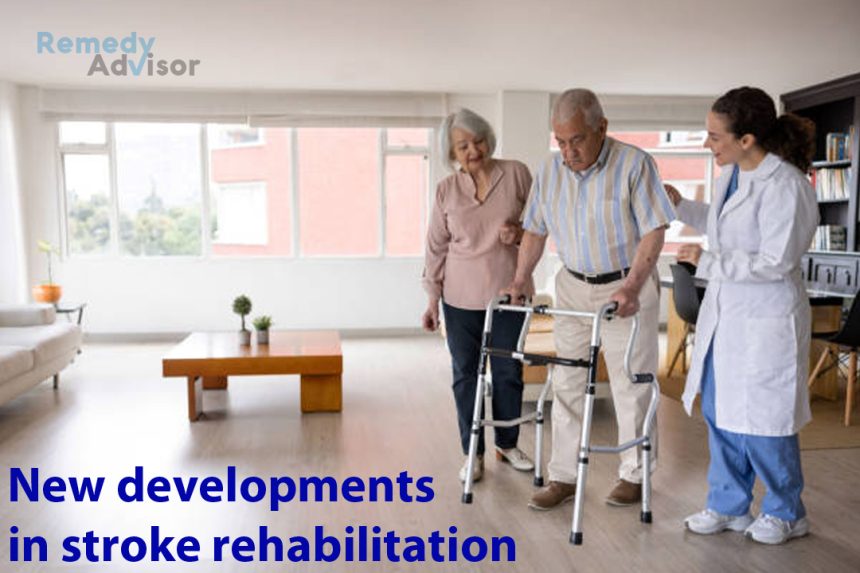Majority of stroke patients need rehabilitation to improve their bodily skills and to recover the capability to live self-sufficiently. Latest improvements in stroke rehabilitation are assisting patients recover faster and better, occasionally even numerous years after the stroke.
Following treatments are the latest methods to recover stroke. Look with the stroke centers located in your area about what is available.
Arms and legs
Stroke patients often require physical therapy for arm or leg weakness or immobility. Repetitive physical movements prevent muscle atrophy and enhance the brain cells in the area surrounding the stroke damage. Breakthrough therapies…
• Robotic therapy
MIT researchers have developed the tabletop robot MIT-Manus, which significantly improves arm mobility and may be more effective than conventional physical therapy.
How it works: The patient puts his/her lower arm and wrist into a brace connected to the robot. Video screen stimulates the patient to do arm workouts, such as connecting dots on the screen. The robot monitors movement and increases or decreases resistance as required and even moves the arm if the patient is unable to do so. The robot can move the arm thousands of times in a single session and detects (and responds to) movements and muscle tension that are too subtle for the patient to notice.
Patients who use robotic therapies have muscle strength scores that are about twice as high as those undergoing traditional physical therapy.
Most patients enjoy the interactive nature of this “video game” therapy. It gives immediate feedback and boosts their motivation to keep trying. Between 18 and 36 sessions are needed.
• Bilateral arm training with rhythmic auditory cueing (BATRAC)
When patients move both the damaged arm and the healthy arm together (bilateral movement), the healthy side of the brain promotes better functioning in the side damaged by stroke.
How it works: The patient works with an occupational therapist for about an hour several days a week. He performs movements to the beat of a metronome or other auditory device. He moves both arms simultaneously for example, moving arms away from the body, then moving them back in. Early studies indicate that patients treated with BATRAC have greater improvements in upper-extremity motor function than those who are treated with conventional therapy.
• Constraint-induced movement therapy
When a stroke victim has trouble moving a limb, damage to the brain’s sensory cortex may cause him to lose awareness of that hand, arm or leg and he stops moving it entirely.
How it works: In constraint-induced therapy, placing the healthy limb in a sling forces the patient to use the disabled limb, thereby facilitating the regaining of movement control. This approach requires the patient to practice for up to six hours a day for several weeks. He might be asked to pick up a block of wood, sweep floors, throw balls or draw pictures repeatedly.
The therapy is performed in a clinic setting, often in groups to encourage participation and enhance motivation.
Studies show that this approach results in improvements in motor function and muscle strength.
Walking
Patients who are in conventional rehabilitation programs typically use canes or leg braces for support.
For safety reasons, they walk slowly, and they may not reach their optimal level of recovery.
• Body weight support
With body weight support, patients can more than double their speed. Faster walking hastens recovery and prepares patients for the types of movements they will need in daily life, such as quickly crossing a street.
How it works: The patient is suspended in a harness attached to a weight-support system. The harness prevents the patient from falling, so he can increase the speed of the treadmill and push himself harder. The harness adjusts to support more or less of the patient’s body weight, depending on his progress.
Swallowing
Many patients experience difficulty swallowing (dysphagia). Traditionally, speech therapists teach patients how to initiate normal swallowing movements.
• Vital Stim therapy
Electrical stimulation applied to the neck causes the muscles that are involved in swallowing to activate at the appropriate times. This approach is effective in as little as one week.
How it works: Electrodes are placed on the neck. Electrical currents stimulate muscles in the throat to contract. The treatment, lasting 20 to 30 minutes, may be repeated 10 or more times over a week. It retrains the brain to stimulate involuntary swallowing movements.
Drawbacks: This does not work for all patients. Many require speech therapy sessions. Also, the treatment may be uncomfortable it causes a feeling of tightness in the neck, as though one is being grabbed by the throat.
Vision
•Visual retraining
Stroke victims who experience vision damage can gain significant improvement from a technique called visual retraining, or vision restoration therapy.
How it works: The patient fixes his eyes on a spot on a monitor, and then clicks a button when he becomes aware that another dot has appeared in the periphery. This stimulates neurons in the visual center of the brain. Sessions usually are 30 minutes, twice daily, for six months.
A study presented at the American Stroke Association International Conference reported that patients were able to detect 62% of the peripheral dots after six months, compared with 54% when they began. Follow-up studies show that 70% of patients maintain the improvement more than a year later.
Beware of depression
Depression is common in stroke patients in the first year.
One study found that patients who suffer post-stroke depression are 3.3 times more likely to die within 10 years than those who aren’t depressed.
Stroke patients should be evaluated for depression and, if diagnosed, given appropriate treatment, which can include psychotherapy and/or antidepressants. Treatment can greatly improve patients’ motivation and increase their rate of recovery.







